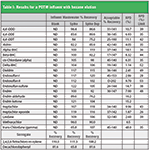Analysis of Wastewater Samples Using Disk Solid-Phase Extraction (SPE) Following US EPA Method 608.3
The Application Notebook
Pesticides have gone far in increasing food supply, important in a world expecting to have 9.8 billion people by 2050. However, the mechanisms that make pesticides effective in eliminating pests can also cause harm to humans and animals. News stories continue to point to contamination through spills and exposure through the respiratory system. This work demonstrates the use of SPE disks on wastewater samples using automation to provide control and consistency in all the steps in the extraction process, including conditioning the disk, loading the water sample, rinsing the sample bottle, and eluting the sample in solvent. Since the use of a halogen-specific detector precludes use of a chlorinated solvent for the sample, the method specifies solvent exchange from methylene chloride into hexane before the analysis step. When SPE is used, the extraction and elution steps are separate, so extraction onto the SPE disk is one step and then elution can be considered separately. Since the final extract should be in hexane, it is possible to elute the disk directly into hexane, eliminating the elution with methylene chloride and subsequent solvent exchange step. Both elution with methylene chloride and elution with hexane are demonstrated in the full note.
The results are very good for a complex matrix such as wastewater influent, shown in the table, meeting the goals in all cases for spike recovery. In the case of trans-chlordane, however, the agreement between the spike and spike duplicate is outside the acceptable range. There was some interference with the chromatography and the spike was cleaned with copper. The spike duplicate appeared cleaner and was not treated with copper. This issue was not observed with synthetic wastewater and was unexpected. The particulate matter in the spike and spike duplicate were different in amount and color. This could have contributed to a matrix effect which influenced the recovery of compounds more in one sample than the other, in spite of the copper treatment.

Elution with hexane can save time and effort required in solvent exchange required for an ECD detector, improving the workflow in a busy laboratory. Analysis of a medium-sized wastewater treatment plant influent wastewater showed good results using the hexane elution procedure, further demonstrating the ability of automated disk SPE to improve the laboratory workflow while maintaining method performance.
Reference
(1) W.R. Jones and Z.A, Grosser, "Analysis of Wastewater Samples Using Disk Solid Phase Extraction (SPE) Following US EPA Method 608.3, AN1151707_01," available from www.horizontechinc.com.

Horizon Technology, Inc.
16 Northwestern Dr., Salem, NH 03079
tel. (603) 893-3663, fax (603) 893-4994
Website: www.horizontechinc.com

Separation of Ultra-Short and Long Chain PFAS Compounds Using a Positive Charge Surface Column
December 11th 2024A separation of ultra-short and long chain PFAS (C1-C18) is performed on a HALO®PCS Phenyl-Hexyl column along with a HALO®PFAS Delay column which demonstrates excellent retention for both hydrophilic and hydrophobic analytes.















